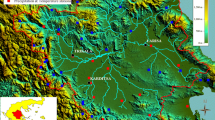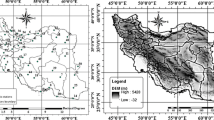Abstract
Projections of climate change are essential to guide sustainable development plans in the tropical Andean countries such as Peru. This study assessed the projections of precipitation and potential evaporation, rain erosive potential, and precipitation concentration in the Mantaro River Basin, in the Peruvian Andes, which is important for agriculture and energy production in Peru. We assumed the Intergovernmental Panel on Climate Change (IPCC) A1B greenhouse gas emission scenario and simulated the global climate change by the HadCM3 global climate model. Due to the steepness of the mountain slopes and the narrowness of the river valley, this study uses the downscaling of the global model simulations by the regional Eta model down to 20-km resolution. The downscaling projections show decrease in the monthly precipitation with respect to the baseline period, especially during the rainy season, between February and April, until the end of the 21st century. Meanwhile, a progressive increase in the monthly evaporation from the baseline period is projected. The Modified Fournier Index (MFI) shows a statistically significant downward trend in the Mantaro River Basin, which suggests a possible reduction in the rain erosive potential. The Precipitation Concentration Index (PCI) shows a statistically significant increasing trend, which indicates increasingly more irregular temporal distribution of precipitation towards the end of the century. The results of this study allow us to conclude that there should be a gradual increase in water deficit and precipitation concentration. Both changes can be negative for agriculture, power generation, and water supply in the Mantaro River Basin in Peru.
Similar content being viewed by others
References
Aragão LEOC, Marengo JA, Cox PM, et al. (2016) Assessing the Influence of Climate Extremes on Ecosystems and Human Health in Southwestern Amazon Supported by the PULSEBrazil Platform. American Journal of Climate Change 5(3): 399–416. https://doi.org/10.4236/ajcc.2016.53030
Arnoldus HMJ (1977) Methodology used to determine the maximum potential average annual soil loss due to sheet and rill erosion in Morocco. Assessing Soil Degradation, FAO Soils Bulletin (FAO) 34: 39–48.
Boers N, Bookhagen B, Barbosa HMJ, et al. (2014) Prediction of extreme floods in the eastern Central Andes based on a complex networks approach. Nature Communications 5: 5199. https://doi.org/10.1038/ncomms6199
Bradley RS, Vuille M, Diaz HF, et al. (2006) Threats to water supplies in the tropical Andes. Science 312(5781): 1755–1756. https://doi.org/10.1126/science.1128087
Buja L, Craig T (2002) CCSM2 user’s guide. Community Climate System Model. National Center for Atmospheric Research. p 69.
Commission of the European Communities (CEC) (1992) CORINE soil erosion risk and important land resources in the southern regions of the European Community. Commission of the European Communities, Luxembourg.
Correa SW, Mello CR, Chou SC, et al. (2016) Soil erosion risk associated with climate change at Mantaro River basin, Peruvian Andes. Catena 147: 110–124. https://doi.org/10.1016/j.catena.2016.07.003
Chou SC, Lyra A, Mourão C, et al. (2014) Evaluation of the Eta Simulations Nested in Three Global Climate Models. American Journal of Climate Change 3 (5): 438–454. https://doi.org/10.4236/ajcc.2014.35043
Chou SC, Marengo JA, Lyra A, et al. (2012) Downscaling of South America present climate driven by 4-member HadCM3 runs. Climate Dynamics 38(3–4): 635–653. https://doi.org/10. 1007/s00382-011-1002-8
Chou SC, Lyra AA, Gomes JL, et al. (2014) Cenários Climáticos Regionais Futuros com Modelo Eta. In: Lima JWM, Collischonn W, Marengo JA (eds.), Efeitos das Mudanças Climáticas na Geração de Energia Elétrica, 1st edn. São Paulo AeS Tietê. pp 65–94. (In Portuguese)
Funk C, Peterson P, Landsfeld M, et al. (2015) The climate hazards infrared precipitation with stations-a new environmental record for monitoring extremes. Scientific Data 2: 150066, https://doi.org/10.1038/sdata.2015.66
Gabriels D, Vermeulen A, Verbist K, et al. (2003) Assessment of rain erosivity and precipitation concentration in Europe. In: Gabriels D, Cornelis W (eds.), Proceedings of the International Symposium 25 Years of Assessment of Erosion, Ghent. pp 87–92. https://doi.org/10.1016/j.scitotenv.2015.01.008
Hausfather Z, Cowtan K, Clarke DC, et al. (2017) Assessing recent warming using instrumentally homogeneous sea surface temperature records. Science Advances 3: e1601207. https//doi.org/10.1126/sciadv.1601207
Instituto Geofísico Del Perú (IGP) (2005) Environmental assessment of the Mantaro River Basin under climate change perspective. Lima, Perú. (In Spanish)
Instituto Nacional de Estadística e Informática (INEI) (2011) Peru: evolution of the indicators of employment and hirings by states, 2001-2010. Lima, Perú. (In Spanish)
Intergovernmental Panel on Climate Change (IPCC) (2007) Climate change 2007: synthesis report: contribution of working groups I, II and III to the Fourth Assessment Report of the Intergovernmental Panel on Climate Change. Geneva.
IPCC (2007) Climate Change 2007: The Physical Science Basis. Contribution of Working Group I to the Fourth Assessment Report of the Intergovernmental Panel on Climate Change. In: Solomon S, Qin D, Manning M, et al. (Eds.), Cambridge University Press, Cambridge, United Kingdom and New York. p 996.
IPCC (2013) Climate Change 2013: The Physical Science Basis. Contribution of Working Group I to the Fifth Assessment Report of the Intergovernmental Panel on Climate Change. In: Stocker TF, Qin D, Plattner GK, et al. (Eds.), Cambridge University Press, Cambridge, United Kingdom and New York. p 1535. https://doi.org/10.1017/CBO9781107415324
Intergovernmental Panel on Climate Change (IPCC) (2014) Climate Change 2014: Mitigation of Climate Change. Contribution of Working Group III to the Fifth Assessment Report of the Intergovernmental Panel on Climate Change, Cambridge University Press, Cambridge, United Kingdom and New York, NY, USA.
Intergovernmental Panel on Climate Change (IPCC) (2000) IPCC special report: emissions scenarios: a special report of IPCC Working Group III. Geneva.
Jordán A, Bellinfante N (2000) Mapping of the estimated rainfall erosivity from monthly rainfall records in Campo de Gibraltar (Cádiz). Edafología 7: 83–92. (In Spanish with Abstract in English)
Kendall MG, Stuart A (1967) The advanced theory of statistics. 2nd ed. C Griffin, London.
Lavado CW, Fernandez C, Vega F, et al. (2015) PISCO: Peruvian Interpolated data of the SENAMHI’s Climatological and hydrological Observations. Precipítación v1.0
Luis M, Gonzáles-Hidalgo JC, Brunetti M, et al. (2011) Precipitation concentration changes in Spain 1946-2005. Natural Hazards and Earth System Sciences 11 (5): 1259–1265. https://doi.org/10.5194/nhess-11-1259-2011.
Mann HB (1945) Non-parametric tests against trend. Econometrica 13: 245–259. https://doi.org/10.2307/1907187
Marcott SA, Shakun JD, Clark PU, et al. (2013) A Reconstruction of Regional and Global Temperature for the Past 11,300 Years. Science 339(6124): 1198–1201. https://doi. org/10.1126/science.1228026
Marengo JA, Chou SC, Kay G, et al. (2012) Development of regional future climate change scenarios in South America using the Eta CPTEC/HadCM3 climate change projections: Climatology and regional analyses for the Amazon, São Francisco and the Parana River Basins. Climate Dynamics 38(9–10): 1829–1848. https://doi.org/10.1007/s00382-011-1155-5
Marengo J, Nobre C, Raigoza D, et al. (2007) Bulletin of the project: use of the regional climate change scenarios in the studies of vulnerability and adaptation in Brazil and South America (GOF-UK-CPTEC). INPE, São José dos Campos. Available online: http://www.cptec.inpe.br/mudancas_climaticas, accessed July 2014). (In Portuguese)
Mello CR, Viola MR, Owens PR, et al. (2015a) Interpolation methods for improving the RUSLE R-factor mapping in Brazil. Journal of Soil and Water Conservation 70(3): 182–197. https://doi.org/10.2489/jswc.70.3.182
Mello CR, Ávila LF, Viola MR, et al. (2015b) Assessing the climate change impacts on the rainfall erosivity throughout the twenty-first century in the Grande River Basin (GRB) headwaters, Southeastern Brazil. Environmental Earth Sciences 73(12): 8683–8698. https//doi.org/10.1007/s12665-015-4033-3
Mello CR, Viola MR, Beskow S, et al. (2013) Multivariate models for annual rainfall erosivity in Brazil. Geoderma 202-203 (July 2013): 88–102. https://doi.org/10.1016/j.geoderma. 2013.03.009
Mesinger F, Chou SC, Gomes JL, et al. (2012) An upgraded version of the Eta model. Meteorology and Atmospheric Physics 116(3): 63–79. https://doi.org/10.1007/s00703-012-0182-z
Mesinger F (1984) A Blocking Technique for Representation of Mountains in Atmospheric Models. Rivista di Meteorologia Aeronautica 44: 195–202.
Michiels P, Gabriels D (1996) Rain variability indices for the assessment of rainfall erosivity in the Mediterranean region. In: Rubio JL, Calva A (Eds.), Soil Degradation and Desertification in Mediterranean Environments. Geoforma editions, Logroño, Spain. pp 49–70.
Ministry of Agriculture of Peru (MINAG) (2010a) Evaluation of Surface Water Resources in the Mantaro River Basin. Directorate of the Conservation and Planning of Surface Water Resources. Lima, Peru. (In Spanish)
Ministry of Agriculture of Peru (MINAG) (2010b) Peru and Climate Change. Second National Communication of Peru to the United Nations Framework Convention on Climate Chang. Lima, Peru. (In Spanish)
Ministry of Agriculture of Peru (MINAG) (2012) IV National Agricultural Census. Lima, Peru. (In Spanish)
Nakicenovic N, Alcamo J, Davis G, et al. (2000) Special report on emissions scenarios. Cambridge University Press: Cambridge.
New M, Lister D, Hulme M, et al. (2002) A high-resolution data set of surface climate over global land areas. Climate Research 21(1): 1–25. https://doi.org/10.3354/cr021001
Oliver JE (1980) Monthly precipitation distribution: a comparative index. Professional Geographer 32: 300–309. https://doi.org/10.1111/j.0033-0124.1980.00300.x
Pascual JA, Añó VC, Sánchez DJ, et al. (2001) Assessment of the suitability of the PCI and MFI indices to estimate the concentration and aggressiveness of precipitation in the Valencian Community. Cuaternario y Geomorfología 15(3–4): 77–84. (In Spanish with Abstract in English).
Pulgar VJ (1981) Geography of Peru: the eight natural geographical regions of Peru. 8. ed, Lima. (In Spanish)
Ramirez E, Francou B, Ribstein P (2001) Small glaciers disappearing in the tropical Andes: a case-study in Bolivia: Glaciar Chacaltaya (16° S). Journal of Glaciology 47(157): 187–194. https://doi.org/10.3189/172756501781832205
Remigio AJ (2009) Synthesis report on key issues relating to the agriculture sector (adaptation). United Nations Development Programme (UNDP). (In Spanish)
Permanent Seminar on Agricultural Research (SEPIA) (2010) Peru: The agrarian problem under discussion SEPIA XIII, SEPIA. Lima, Perú. (In Spanish)
Thomas DSG, Twyman C, Osbahr H, Hewitson B (2007) Adaptation to Climate Change and Variability: Farmer Responses to Intra-Seasonal Precipitation Trends in South Africa. Climatic Change 83(3): 301–322. https://doi.org/10.10 07/s10584-006-9205-4
Torres RR, Marengo JO (2013) Uncertainty assessments of climate change projections over South America. Theoretical and Applied Climatology 112(1–2): 253–272. https://doi. org/10.1007/s00704-012-0718-7
United States Geological Survey (USGS) (2005) Computer program for the Kendall family of trend tests: scientific investigations report 2005-5275. Virginia, USA.
United States Geological Survey (USGS) (2004) Trends in streamflow characteristics at long-term Gaging Stations, Hawaii: scientific investigations report 2004-5080. Virginia, USA.
Vergara W (2005) Adapting to climate change: lessons learned, work in progress and proposed next steps for the World Bank in Latin America. World Bank Latin America Region, (Sustainable Development Series, 25), Washington.
Viola MR, Mello CR, Chou SC, et al. (2015) Assessing climate change impacts on Upper Grande River Basin hydrology, Southeast Brazil. International Journal of Climatology 35(6): 1054–1068. https://doi.org/10.1002/joc.4038.
Vuille M (2013) Climate Change and Water Resources in the Tropical Andes, Inter-American Development Bank, Environmental Safeguards Unit, Technical Note IDB-TN-515.
Vuille M, Francou B, Wagnon P, et al. (2008) Climate change and tropical Andean glaciers: Past, present and future. Earth-Science Reviews 89: 79–96. https://doi.org/10.1016/j. earscirev.2008.04.002
Wischmeier WH, Smith DD (1978). Predicting rainfall erosion losses-a guide to conservation planning. Agriculture Handbook No. 537, USDA, Washington.
Zeri M, Sá LDA, Manzi AO, et al. (2014) Variability of Carbon and Water Fluxes Following Climate Extremes over a Tropical Forest in Southwestern Amazonia. Plos One 9(2): p. e88130. https://doi.org/10.1371/journal.pone.0088130
Acknowledgements
The authors wish to thank FAPEMIG (PPM X - 45-16), and CNPq for sponsoring this research. This work was partially funded by CNPq 308035/2013-5.
Author information
Authors and Affiliations
Corresponding author
Rights and permissions
About this article
Cite this article
Wongchuig, S.C., Mello, C.R. & Chou, S.C. Projections of the impacts of climate change on the water deficit and on the precipitation erosive indexes in Mantaro River Basin, Peru. J. Mt. Sci. 15, 264–279 (2018). https://doi.org/10.1007/s11629-017-4418-8
Received:
Revised:
Accepted:
Published:
Issue Date:
DOI: https://doi.org/10.1007/s11629-017-4418-8




